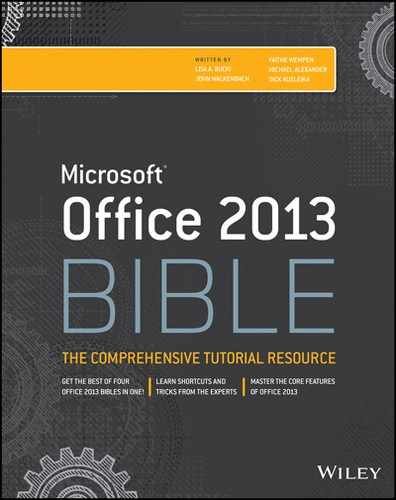Chapter 15
Introducing Formulas and Functions
IN THIS CHAPTER
Understanding formula basics
Entering formulas and functions into your worksheets
Understanding how to use references in formulas
Correcting common formula errors
Getting tips for working with formulas
Formulas are what make a spreadsheet program so useful. If it weren’t for formulas, a spreadsheet would simply be a fancy word-processing document that has great support for tabular information. You use formulas in your Excel worksheets to calculate results from the data stored in the worksheet. When data changes, the formulas calculate updated results with no extra effort on your part. This chapter introduces formulas and functions and helps you get up to speed with this important element.
Understanding Formula Basics
A formula consists of special code entered into a cell. It performs a calculation of some type and returns a result, which is displayed in the cell. Formulas use a variety of operators and worksheet functions to work with values and text. The values and text used in formulas can be located in other cells, which makes changing data easy and gives worksheets their dynamic nature. For example, you can see multiple scenarios quickly by changing the data in a worksheet and letting your formulas do the work.
A formula can consist of any of these elements:
- Mathematical operators, such as + (for addition) and * (for multiplication)
- Cell references (including named cells and ranges)
- Values or text
- Worksheet functions (such as SUM or AVERAGE)
After you enter a formula, the cell displays the calculated result of the formula. The formula itself appears in the Formula bar when you select the cell, however.
Here are a few examples of formulas:
| =150*.05 | Multiplies 150 times 0.05. This formula uses only values, and it always returns the same result. You could just enter the value 7.5 into the cell. |
| =A3 | Returns the value in cell A3. No calculation is performed. |
| =A1+A2 | Adds the values in cells A1 and A2. |
| =Income–Expenses | Subtracts the value in the cell named Expenses from the value in the cell named Income. |
| =SUM(A1:A12) | Adds the values in the range A1:A12, using the SUM function. |
| =A1=C12 | Compares cell A1 with cell C12. If the cells are identical, the formula returns TRUE; otherwise, it returns FALSE. |
Note that every formula begins with an equal sign (=). The initial equal sign allows Excel to distinguish a formula from plain text.
Using operators in formulas
Excel formulas support a variety of operators. Operators are symbols that indicate what mathematical operation you want the formula to perform. Table 15.1 lists the operators that Excel recognizes. In addition to these, Excel has many built-in functions that enable you to perform additional calculations.
TABLE 15.1 Operators Used in Formulas
| Operator | Name |
| + | Addition |
| – | Subtraction |
| * | Multiplication |
| / | Division |
| ^ | Exponentiation |
| & | Concatenation |
| = | Logical comparison (equal to) |
| > | Logical comparison (greater than) |
| < | Logical comparison (less than) |
| >= | Logical comparison (greater than or equal to) |
| <= | Logical comparison (less than or equal to) |
| <> | Logical comparison (not equal to) |
You can, of course, use as many operators as you need to perform the desired calculation.
Here are some examples of formulas that use various operators.
| Formula | What it does |
| ="Part-"&"23A" | Joins (concatenates) the two text strings to produce Part-23A. |
| =A1&A2 | Concatenates the contents of cell A1 with cell A2. Concatenation works with values as well as text. If cell A1 contains 123 and cell A2 contains 456, this formula would return the text 123456. |
| =6^3 | Raises 6 to the third power (216). |
| =216^(1/3) | Raises 216 to the 1/3 power. This is mathematically equivalent to calculating the cube root of 216, which is 6. |
| =A1<A2 | Returns TRUE if the value in cell A1 is less than the value in cell A2. Otherwise, it returns FALSE. Logical comparison operators also work with text. If A1 contains Bill and A2 contains Julia, the formula would return TRUE because Bill comes before Julia in alphabetical order. |
| =A1<=A2 | Returns TRUE if the value in cell A1 is less than or equal to the value in cell A2. Otherwise, it returns FALSE. |
| =A1<>A2 | Returns TRUE if the value in cell A1 isn’t equal to the value in cell A2. Otherwise, it returns FALSE. |
Understanding operator precedence in formulas
When Excel calculates the value of a formula, it uses certain rules to determine the order in which the various parts of the formula are calculated. You need to understand these rules so your formulas produce accurate results.
Table 15.2 lists the Excel operator precedence. This table shows that exponentiation has the highest precedence (performed first) and logical comparisons have the lowest precedence (performed last).
TABLE 15.2 Operator Precedence in Excel Formulas
| Symbol | Operator | Precedence |
| ^ | Exponentiation | 1 |
| * | Multiplication | 2 |
| / | Division | 2 |
| + | Addition | 3 |
| – | Subtraction | 3 |
| & | Concatenation | 4 |
| = | Equal to | 5 |
| < | Less than | 5 |
| > | Greater than | 5 |
You can use parentheses to override Excel’s built-in order of precedence. Expressions within parentheses are always evaluated first. For example, the following formula uses parentheses to control the order in which the calculations occur. In this case, cell B3 is subtracted from cell B2, and the result is multiplied by cell B4:
=(B2-B3)*B4If you enter the formula without the parentheses, Excel computes a different answer. Because multiplication has a higher precedence, cell B3 is multiplied by cell B4. Then this result is subtracted from cell B2, which isn’t what was intended.
The formula without parentheses looks like this:
=B2-B3*B4It’s a good idea to use parentheses even when they aren’t strictly necessary. Doing so helps to clarify what the formula is intended to do. For example, the following formula makes it perfectly clear that B3 should be multiplied by B4, and the result subtracted from cell B2. Without the parentheses, you would need to remember Excel’s order of precedence.
=B2-(B3*B4)You can also nest parentheses within formulas — that is, put them inside other parentheses. If you do so, Excel evaluates the most deeply nested expressions first — and then works its way out. Here’s an example of a formula that uses nested parentheses:
=((B2*C2)+(B3*C3)+(B4*C4))*B6This formula has four sets of parentheses — three sets are nested inside the fourth set. Excel evaluates each nested set of parentheses and then sums the three results. This result is then multiplied by the value in cell B6.
Although the preceding formula uses four sets of parentheses, only the outer set is really necessary. If you understand operator precedence, it should be clear that you can rewrite this formula as:
=(B2*C2+B3*C3+B4*C4)*B6But most would agree that using the extra parentheses makes the calculation much clearer.
Every left parenthesis, of course, must have a matching right parenthesis. If you have many levels of nested parentheses, keeping them straight can sometimes be difficult. If the parentheses don’t match, Excel displays a message explaining the problem — and won’t let you enter the formula.
In some cases, if your formula contains mismatched parentheses, Excel may propose a correction to your formula. Figure 15.1 shows an example of a proposed correction. You may be tempted simply to accept Excel’s suggestion, but be careful — in many cases, the proposed formula, although syntactically correct, isn’t the formula you intended and it will produce an incorrect result.
FIGURE 15.1 Excel sometimes suggests a syntactically correct formula, but not the formula you had in mind.
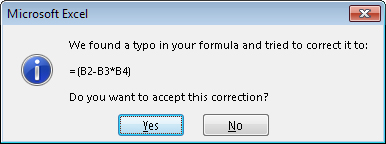
Using functions in your formulas
Many formulas you create use worksheet functions. These functions enable you to greatly enhance the power of your formulas and perform calculations that are difficult (or even impossible) if you use only the operators discussed previously. For example, you can use the TAN function to calculate the tangent of an angle. You can’t do this complicated calculation by using the mathematical operators alone.
Examples of formulas that use functions
A worksheet function can simplify a formula significantly.
Here’s an example. To calculate the average of the values in ten cells (A1:A10) without using a function, you’d have to construct a formula like this:
=(A1+A2+A3+A4+A5+A6+A7+A8+A9+A10)/10Not very pretty, is it? Even worse, you would need to edit this formula if you added another cell to the range. Fortunately, you can replace this formula with a much simpler one that uses one of Excel’s built-in worksheet functions, AVERAGE:
=AVERAGE(A1:A10)The following formula demonstrates how using a function can enable you to perform calculations that are not otherwise possible. Say you need to determine the largest value in a range. A formula can’t tell you the answer without using a function. Here’s a formula that uses the MAX function to return the largest value in the range A1:D100:
=MAX(A1:D100)Functions also can sometimes eliminate manual editing. Assume that you have a worksheet that contains 1,000 names in cells A1:A1000, and the names appear in all-capital letters. Your boss sees the listing and informs you that the names will be mail-merged with a form letter. All-uppercase letters is not acceptable; for example, JOHN F. SMITH must now appear as John F. Smith. You could spend the next several hours re-entering the list (ugh), or you could use a formula, such as the following, which uses the PROPER function to convert the text in cell A1 to the proper case:
=PROPER(A1)Enter this formula once in cell B1 and then copy it down to the next 999 rows. Then select B1:B1000 and choose Home ⇒ Clipboard ⇒ Copy to copy the range. Next, with B1:B1000 still selected, choose Home ⇒ Clipboard ⇒ Paste arrow ⇒ Paste Values (V) to convert the formulas to values. Delete the original column, and you’ve just accomplished several hours of work in less than a minute.
One last example should convince you of the power of functions. Suppose you have a worksheet that calculates sales commissions. If the salesperson sold more than $100,000 of product, the commission rate is 7.5 percent; otherwise, the commission rate is 5.0 percent. Without using a function, you would have to create two different formulas and make sure that you use the correct formula for each sales amount. A better solution is to write a formula that uses the IF function to ensure that you calculate the correct commission, regardless of sales amount:
=IF(A1<100000,A1*5%,A1*7.5%)This formula performs some simple decision making. The formula checks the value of cell A1. If this value is less than 100,000, the formula returns cell A1 multiplied by 5 percent. Otherwise, it returns what’s in cell A1 multiplied by 7.5 percent. This example uses three arguments, separated by commas. I discuss this in the upcoming section, “Function arguments.”
- ISFORMULA: Returns TRUE if the referenced cell contains a formula
- FORMULATEXT: Returns the formula in the referenced cell, as text
- SHEET: Returns the sheet number of the referenced sheet. For example, =SHEET(“Sheet3”) returns the sheet number for Sheet3.
- SHEETS: Returns the number of sheets in a workbook. For example, =SHEETS() returns the number of sheets in the workbook.
- IFNA: If a reference contains a #NA error, returns other text you specify
Function arguments
In the preceding examples, you may have noticed that all the functions used parentheses. The information inside the parentheses is the list of arguments.
Functions vary in how they use arguments. Depending on what it has to do, a function may use:
- No arguments
- One argument
- A fixed number of arguments
- An indeterminate number of arguments
- Optional arguments
An example of a function that doesn’t use an argument is the NOW function, which returns the current date and time. Even if a function doesn’t use an argument, you must still provide a set of empty parentheses, like this:
=NOW()If a function uses more than one argument, you must separate each argument with a comma. The examples at the beginning of the chapter used cell references for arguments. Excel is quite flexible when it comes to function arguments, however. An argument can consist of a cell reference, literal values, literal text strings, expressions, and even other functions. Here are some examples of functions that use various types of arguments:
- Cell reference: =SUM(A1:A24)
- Literal value: =SQRT(121)
- Literal text string: =PROPER("john smith")
- Expression: =SQRT(183+12)
- Other functions: =SQRT(SUM(A1:A24))
More about functions
All told, Excel includes more than 450 functions. And if that’s not enough, you can download or purchase additional specialized functions from third-party suppliers — and even create your own custom functions (by using VBA) if you’re so inclined.
Some users feel a bit overwhelmed by the sheer number of functions, but you’ll probably find that you use only a dozen or so on a regular basis. And as you’ll see, the Excel Insert Function dialog box (described later in this chapter) makes it easy to locate and insert a function, even if it’s not one that you use frequently.
Entering Formulas into Your Worksheets
Every formula must begin with an equal sign to inform Excel that the cell contains a formula rather than text. Excel provides two ways to enter a formula into a cell: manually, or by pointing to cell references. The following sections discuss each way in detail.
Excel provides additional assistance when you create formulas by displaying a drop-down list that contains function names and range names. The items displayed in the list are determined by what you’ve already typed. For example, if you’re entering a formula and then type the letters SU, you’ll see the drop-down list shown in Figure 15.2. If you type an additional letter, the list is shortened to show only the matching functions. To have Excel AutoComplete an entry in that list, use the navigation keys to highlight the entry, and then press Tab. Notice that highlighting a function in the list also displays a brief description of the function. See the sidebar “Using Formula AutoComplete” for an example of how this feature works.
FIGURE 15.2 Excel displays a drop-down list when you enter a formula.
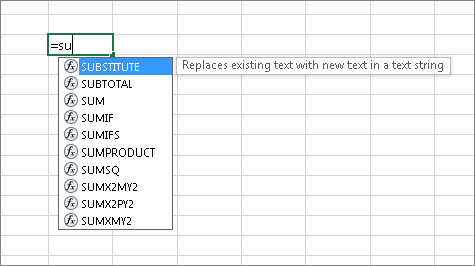
=AGGREGATE(1,2,TestScores)- Excel built-in functions
- User-defined functions (functions defined by the user through VBA or other methods)
- Defined names (cells or range named using the Formulas ⇒ Defined Names ⇒ Define Name command)
- Enumerated arguments that use a value to represent an option (only a few functions use such arguments, and AGGREGATE is one of them)
- Table structure references (used to identify portions of a table)
Entering formulas manually
Entering a formula manually involves, well, entering a formula manually. In a selected cell, you simply type an equal sign (=) followed by the formula. As you type, the characters appear in the cell and in the Formula bar. You can, of course, use all the normal editing keys when entering a formula.
Entering formulas by pointing
Even though you can enter formulas by typing in the entire formula, Excel provides another method of entering formulas that is generally easier, faster, and less error prone. This method still involves some manual typing, but you can simply point to the cell references instead of typing their values manually. For example, to enter the formula =A1+A2 into cell A3, follow these steps:
Pasting range names into formulas
If your formula uses named cells or ranges, you can either type the name in place of the address, or choose the name from a list and have Excel insert the name for you automatically. Two ways to insert a name into a formula are available:
- Select the name from the drop-down list. To use this method, you must know at least the first character of the name. When you’re entering the formula, type the first character and then select the name from the drop-down list.
- Press F3. The Paste Name dialog box appears. Select the name from the list and then click OK (or just double-click the name). Excel enters the name into your formula. If no names are defined, pressing F3 has no effect.
Figure 15.3 shows an example. The worksheet contains two defined names: Expenses and Sales. The Paste Name dialog box is being used to insert a name (Sales) into the formula being entered in cell B9.
FIGURE 15.3 Use the Paste Name dialog box to quickly enter a defined name into a formula.
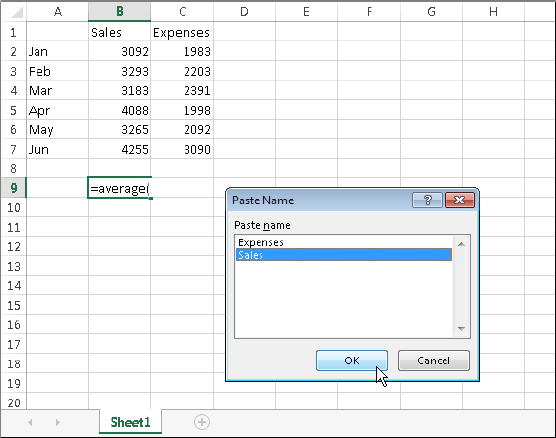
Inserting functions into formulas
The easiest way to enter a function into a formula is to use Formula AutoComplete (the drop-down list that Excel displays while you type a formula). To use this method, however, you must know at least the first character of the function’s name.
Another way to insert a function is to use tools in the Function Library group on the Formulas tab on the Ribbon (see Figure 15.4). This method is especially useful if you can’t remember which function you need. When entering a formula, click the function category (Financial, Logical, Text, and so on) to get a list of the functions in that category. Click the function you want, and Excel displays its Function Arguments dialog box. This is where you enter the function’s arguments. In addition, you can click the Help on This Function link to learn more about the selected function.
FIGURE 15.4 You can insert a function by selecting it from one of the function categories.

Yet another way to insert a function into a formula is to use the Insert Function dialog box (see Figure 15.5). You can access this dialog box in several ways:
- Choose Formulas ⇒ Function Library ⇒ Insert Function.
- Use the Insert Function command, which appears at the bottom of each drop-down list in the Formulas ⇒ Function Library group.
- Click the Insert Function button, which is directly to the left of the Formula bar. This button displays fx.
- Press Shift+F3.
FIGURE 15.5 The Insert Function dialog box
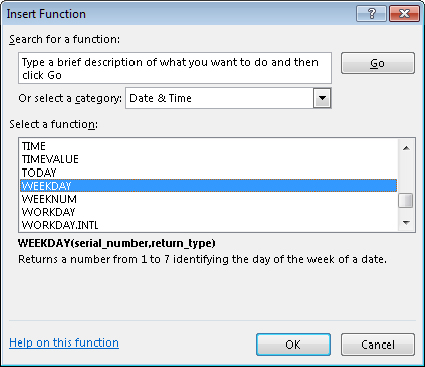
The Insert Function dialog box shows a drop-down list of function categories. Select a category and the functions in that category are displayed in the list box. To access a function that you recently used, select Most Recently Used from the drop-down list.
If you’re not sure which function you need, you can search for the appropriate function by using the Search for a Function field at the top of the dialog box.
FIGURE 15.6 The Function Arguments dialog box

Function entry tips
Here are some additional tips to keep in mind when you use the Insert Function dialog box to enter functions:
- You can use the Insert Function dialog box to insert a function into an existing formula. Just edit the formula and move the insertion point to the location at which you want to insert the function. Then open the Insert Function dialog box (using any of the methods described earlier) and select the function.
- You can also use the Function Arguments dialog box to modify the arguments for a function in an existing formula. Click the function in the Formula bar and then click the Insert Function button (the fx button, to the left of the Formula bar).
- If you change your mind about entering a function, click the Cancel button.
- The number of boxes you see in the Function Arguments dialog box depends on the number of arguments used in the function you selected. If a function uses no arguments, you won’t see any boxes. If the function uses a variable number of arguments (such as the AVERAGE function), Excel adds a new box every time you enter an optional argument.
- As you provide arguments in the Function Arguments dialog box, the value of each argument is displayed to the right of each box.
- A few functions, such as INDEX, have more than one form. If you choose such a function, Excel displays another dialog box that lets you choose which form you want to use.
- As you become familiar with the functions, you can bypass the Insert Function dialog box and type the function name directly. Excel prompts you with argument names as you enter the function.
Editing Formulas
After you enter a formula, you can (of course) edit that formula. You may need to edit a formula if you make some changes to your worksheet and then have to adjust the formula to accommodate the changes. Or the formula may return an error value, in which case you need to edit the formula to correct the error.
Here are some of the ways to get into cell edit mode:
- Double-click the cell, which enables you to edit the cell contents directly in the cell.
- Press F2, which enables you to edit the cell contents directly in the cell.
- Select the cell that you want to edit, and then click in the Formula bar. This enables you to edit the cell contents in the Formula bar.
- If the cell contains a formula that returns an error, Excel will display a small triangle in the upper-left corner of the cell. Click the cell, and you’ll see an error button appear. Click the button, and you can choose one of the options for correcting the error. (The options will vary according to the type of error in the cell.)
While you’re editing a formula, you can select multiple characters either by dragging over them or by pressing Shift while you use the navigation keys.
Using Cell References in Formulas
Most formulas you create include references to cells or ranges. These references enable your formulas to work dynamically with the data contained in those cells or ranges. For example, if your formula refers to cell A1 and you change the value contained in A1, the formula result changes to reflect the new value. If you didn’t use references in your formulas, you would need to edit the formulas themselves in order to change the values used in the formulas.
Using relative, absolute, and mixed references
When you use a cell (or range) reference in a formula, you can use three types of references:
- Relative: The row and column references can change when you copy the formula to another cell because the references are actually offsets from the current row and column. By default, Excel creates relative cell references in formulas.
- Absolute: The row and column references don’t change when you copy the formula because the reference is to an actual cell address. An absolute reference uses two dollar signs in its address: one for the column letter and one for the row number (for example, $A$5).
- Mixed: Either the row or column reference is relative, and the other is absolute. Only one of the address parts is absolute (for example, $A4 or A$4).
The type of cell reference is important only if you plan to copy the formula to other cells. The following examples illustrate this point.
Figure 15.7 shows a simple worksheet. The formula in cell D2, which multiplies the quantity by the price, is
FIGURE 15.7 Copying a formula that contains relative references
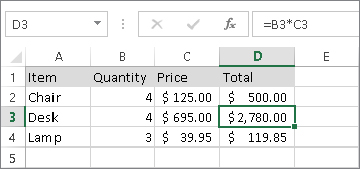
=B2*C2This formula uses relative cell references. Therefore, when the formula is copied to the cells below it, the references adjust in a relative manner. For example, the formula in cell D3 is
=B3*C3But what if the cell references in D2 contained absolute references, like this?
=$B$2*$C$2In this case, copying the formula to the cells below would produce incorrect results. The formula in cell D3 would be exactly the same as the formula in cell D2.
Now I’ll extend the example to calculate sales tax, which is stored in cell B7 (see Figure 15.8). In this situation, the formula in cell D2 is:
=(B2*C2)*$B$7FIGURE 15.8 Formula references to the sales tax cell should be absolute.

The quantity is multiplied by the price, and the result is multiplied by the sales tax rate stored in cell B7. Notice that the reference to B7 is an absolute reference. When the formula in D2 is copied to the cells below it, cell D3 will contain this formula:
=(B3*C3)*$B$7Here, the references to cells B2 and C2 were adjusted, but the reference to cell B7 was not — which is exactly what I want because the address of the cell that contains the sales tax never changes.
Figure 15.9 demonstrates the use of mixed references. The formulas in the C3:F7 range calculate the area for various lengths and widths. The formula in cell C3 is:
=$B3*C$2FIGURE 15.9 Using mixed cell references

Notice that both cell references are mixed. The reference to cell B3 uses an absolute reference for the column ($B), and the reference to cell C2 uses an absolute reference for the row ($2). As a result, this formula can be copied down and across, and the calculations will be correct. For example, the formula in cell F7 is:
=$B7*F$2If C3 used either absolute or relative references, copying the formula would produce incorrect results.
Changing the types of your references
You can enter nonrelative references (that is, absolute or mixed) manually by inserting dollar signs in the appropriate positions of the cell address. Or you can use a handy shortcut: the F4 key. When you’ve entered a cell reference (by typing it or by pointing), you can press F4 repeatedly to have Excel cycle through all four reference types.
For example, if you enter =A1 to start a formula, pressing F4 converts the cell reference to =$A$1. Pressing F4 again converts it to =A$1. Pressing it again displays =$A1. Pressing it one more time returns to the original =A1. Keep pressing F4 until Excel displays the type of reference that you want.
Referencing cells outside the worksheet
Formulas can also refer to cells in other worksheets — and the worksheets don’t even have to be in the same workbook. Excel uses a special type of notation to handle these types of references.
Referencing cells in other worksheets
To use a reference to a cell in another worksheet in the same workbook, use this format:
SheetName!CellAddressIn other words, precede the cell address with the worksheet name, followed by an exclamation point. Here’s an example of a formula that uses a cell on the Sheet2 worksheet:
=A1*Sheet2!A1This formula multiplies the value in cell A1 on the current worksheet by the value in cell A1 on Sheet2.
=A1*'All Depts'!A1Referencing cells in other workbooks
To refer to a cell in a different workbook, use this format:
=[WorkbookName]SheetName!CellAddressIn this case, the workbook name (in square brackets), the worksheet name, and an exclamation point precede the cell address. The following is an example of a formula that uses a cell reference in the Sheet1 worksheet in a workbook named Budget:
=[Budget.xlsx]Sheet1!A1If the workbook name in the reference includes one or more spaces, you must enclose it (and the sheet name) in single quotation marks. For example, here’s a formula that refers to a cell on Sheet1 in a workbook named Budget For 2013:
=A1*'[Budget For 2013.xlsx]Sheet1'!A1When a formula refers to cells in a different workbook, the other workbook doesn’t have to be open. If the workbook is closed, however, you must add the complete path to the reference so that Excel can find it. Here’s an example:
=A1*'C:Usersuser nameMy Documents [Budget For 2013.xlsx]Sheet1'!A1A linked file can also reside on another system that’s accessible on your corporate network. The following formula refers to a cell in a workbook in the files folder of a computer named DataServer:
='DataServerfiles [budget.xlsx] Sheet1'!$D$7Using Formulas in Tables
A table is a specially designated range of cells, set up with column headers. In this section, I describe how formulas work with tables. Chapter 19 will introduce tables.
Summarizing data in a table
Figure 15.10 shows a simple table with three columns. I entered the data and then converted the range to a table by choosing Insert ⇒ Tables ⇒ Table. Note that I didn’t define any names, but the table is named Table1 by default.
FIGURE 15.10 A simple table with three columns of information
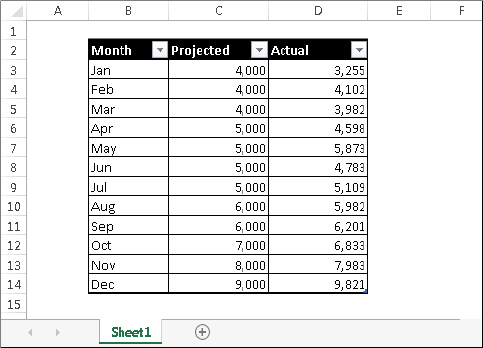
If you’d like to calculate the total projected and total actual sales, you don’t even need to write a formula. Simply click a button to add a row of summary formulas to the table:
FIGURE 15.11 A drop-down list enables you to select a summary formula for a table column.

=SUBTOTAL(109,[Actual])For the SUBTOTAL function, 109 is an enumerated argument that represents SUM. The second argument for the SUBTOTAL function is the column name, in square brackets. Using the column name within brackets creates “structured” references within a table (as discussed further in the upcoming section, “Referencing data in a table”).
Using formulas within a table
In many cases, you’ll want to use formulas within a table to perform calculations that use other columns in the table. For example, in the table shown in Figure 15.11, you may want a column that shows the difference between the Actual and Projected amounts. To add this formula:
Figure 15.12 shows the table with the new column.
FIGURE 15.12 The Difference column contains a formula.
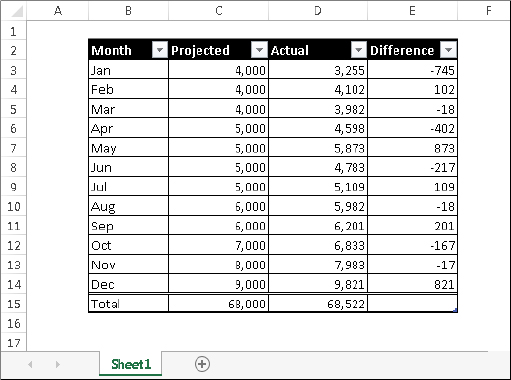
Examine the table, and you find this formula for all cells in the Difference column:
=[@Actual]-[@Projected]Although the formula was entered into the first row of the table, that’s not necessary. Any time a formula is entered into an empty table column, it will automatically fill all the cells in that column. And if you need to edit the formula, Excel will automatically copy the edited formula to the other cells in the column.
These steps use the pointing technique to create the formula. Alternatively, you could have entered the formula manually using standard cell references rather than column headers. For example, you could have entered the following formula in cell E3:
=D3-C3If you type the cell references, Excel will still copy the formula to the other cells automatically.
One thing should be clear, however, about formulas that use the column headers instead of cell references: They’re much easier to understand.
Referencing data in a table
Excel offers some other ways to refer to data that’s contained in a table by using the table name and column headers.
You can, of course, use standard cell references to refer to data in a table, but using the table name and column headers has a distinct advantage: The names adjust automatically if the table size changes by adding or deleting rows. In addition, formulas that use table names and column headers will adjust automatically if you change the name of the table or give a new name to a column.
Refer to the table shown in Figure 15.11. This table is named Table1. To calculate the sum of all the data in the table, enter this formula into a cell outside the table:
=SUM(Table1)This formula will always return the sum of all the data (excluding calculated Total Row values, if any), even if rows or columns are added or deleted. And if you change the name of Table1, Excel will adjust formulas that refer to that table automatically. For example, if you renamed Table1 to AnnualData (by using the Name Manager, or by choosing Table Tools ⇒ Design ⇒ Properties ⇒ Table Name), the preceding formula would change to:
=SUM(AnnualData)Most of the time, a formula will refer to a specific column in the table. The following formula returns the sum of the data in the Actual column:
=SUM(Table1[Actual])Notice that the column name is enclosed in square brackets. Again, the formula adjusts automatically if you change the text in the column heading.
Even better, Excel provides some helpful assistance when you create a formula that refers to data within a table. Figure 15.13 shows the formula AutoComplete helping to create a formula by showing a list of the elements in the table. Notice that, in addition to the column headers in the table, Excel lists other table elements that you can reference: #All, #Data, #Headers, #Totals, and @ - This Row.
FIGURE 15.13 The formula AutoComplete feature is useful when creating a formula that refers to data in a table.

Correcting Common Formula Errors
Sometimes, when you enter a formula, Excel displays a value that begins with a hash mark or pound sign (#). This is a signal that the formula is returning an error value. You have to correct the formula (or correct a cell that the formula references) to get rid of the error display.
In some cases, Excel won’t even let you enter an erroneous formula. For example, the following formula is missing the closing parenthesis:
=A1*(B1+C2If you attempt to enter this formula, Excel informs you that you have unmatched parentheses, and it proposes a correction. Often, the proposed correction is accurate, but you can’t count on it.
Table 15.3 lists the types of error values that may appear in a cell that has a formula. Formulas may return an error value if a cell to which they refer has an error value. This is known as the ripple effect—a single error value can make its way into lots of other cells that contain formulas that depend on that one cell.
TABLE 15.3 Excel Error Values
| Error value | Explanation |
| #DIV/0! | The formula is trying to divide by zero. This also occurs when the formula attempts to divide by what’s in a cell that is empty (that is, by nothing). |
| #NAME? | The formula uses a name that Excel doesn’t recognize. This can happen if you delete a name that’s used in the formula or if you have unmatched quotes when using text. |
| #N/A | The formula is referring (directly or indirectly) to a cell that uses the NA function to signal that data is not available. Some functions (for example, VLOOKUP) can also return #N/A. |
| #NULL! | The formula uses an intersection of two ranges that don’t intersect. |
| #NUM! | A problem with a value exists; for example, you specified a negative number where a positive number is expected. |
| #REF! | The formula refers to a cell that isn’t valid. This can happen if the cell has been deleted from the worksheet. |
| #VALUE! | The formula includes an argument or operand of the wrong type. (An operand is a value or cell reference that a formula uses to calculate a result.) |
Handling circular references
When you’re entering formulas, you may occasionally see a warning message like the one shown in Figure 15.14, indicating that the formula you just entered will result in a circular reference. A circular reference occurs when a formula refers to its own value — either directly or indirectly. For example, you create a circular reference if you enter =A1+A2+A3 into cell A3 because the formula in cell A3 refers to cell A3. Every time the formula in A3 is calculated, it must be calculated again because A3 has changed. The calculation could go on forever.
FIGURE 15.14 If you see this warning, you know that the formula you entered will result in a circular reference.

When you get the circular reference message after entering a formula, Excel gives you two options:
- Click OK, and Excel displays a Help screen that tells you more about circular references.
- Click Cancel to enter the formula as is.
Regardless of which option you choose, Excel displays a message in the left side of the status bar to remind you that a circular reference exists.
Often, a circular reference is quite obvious and easy to identify and correct. But when a circular reference is indirect (as when a formula refers to another formula that refers to yet another formula that refers back to the original formula), it may require a bit of detective work to get to the problem.
Specifying when formulas are calculated
You’ve probably noticed that Excel calculates the formulas in your worksheet immediately. If you change any cells that the formula uses, Excel displays the formula’s new result with no effort on your part. All this happens when Excel’s Calculation mode is set to Automatic. In Automatic Calculation mode (which is the default mode), Excel follows these rules when it calculates your worksheet:
- When you make a change — enter or edit data or formulas, for example — Excel calculates immediately those formulas that depend on new or edited data.
- If Excel is in the middle of a lengthy calculation, it temporarily suspends the calculation when you need to perform other worksheet tasks; it resumes calculating when you’re finished with your other worksheet tasks.
- Formulas are evaluated in a natural sequence. In other words, if a formula in cell D12 depends on the result of a formula in cell D11, Excel calculates cell D11 before calculating cell D12.
Sometimes, however, you may want to control when Excel calculates formulas. For example, if you create a worksheet with thousands of complex formulas, you’ll find that processing can slow to a snail’s pace while Excel does its thing. In such a case, set Excel’s calculation mode to Manual — which you can do by choosing Formulas ⇒ Calculation ⇒ Calculation Options ⇒ Manual (see Figure 15.15).
FIGURE 15.15 You can control when Excel calculates formulas.
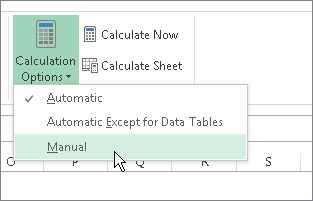
When you’re working in Manual Calculation mode, Excel displays Calculate in the status bar when you have any uncalculated formulas. You can use the following shortcut keys to recalculate the formulas:
- F9: Calculates the formulas in all open workbooks
- Shift+F9: Calculates only the formulas in the active worksheet. Other worksheets in the same workbook aren’t calculated.
- Ctrl+Alt+F9: Forces a complete recalculation of all formulas
Tips for Working with Formulas
In this section, I offer a few additional tips and pointers relevant to formulas.
Not hard-coding values
When you create a formula, think twice before you use any specific value in the formula. For example, if your formula calculates sales tax (which is 6.5%), you may be tempted to enter a formula, such as the following:
=A1*.065A better approach is to insert the sales tax rate in a cell — and use the cell reference. Or you can define the tax rate as a named constant, using the technique presented earlier in this chapter. Doing so makes modifying and maintaining your worksheet easier. For example, if the sales tax rate changed to 6.75%, you would have to modify every formula that used the old value. If you store the tax rate in a cell, however, you simply change that one cell, and Excel updates all the formulas.
Using the Formula bar as a calculator
If you need to perform a quick calculation, you can use the Formula bar as a calculator. For example, enter the following formula — but don’t press Enter:
=(145*1.05)/12If you press Enter, Excel enters the formula into the cell. But because this formula always returns the same result, you may prefer to store the formula’s result rather than the formula itself. To do so, press F9 and watch the result appear in the Formula bar. Press Enter to store the result in the active cell. (This technique also works if the formula uses cell references or worksheet functions.)
Making an exact copy of a formula
When you copy a formula, Excel adjusts its cell references when you paste the formula to a different location. Sometimes, you may want to make an exact copy of the formula. One way to do this is to convert the cell references to absolute values, but this isn’t always desirable. A better approach is to select the formula in Edit mode and then copy it to the Clipboard as text. You can do this in several ways. Here’s a step-by-step example of how to make an exact copy of the formula in A1 and copy it to A2:
You can also use this technique to copy just part of a formula, if you want to use that part in another formula. Just select the part of the formula that you want to copy by dragging the mouse, and then use any of the available techniques to copy the selection to the Clipboard. You can then paste the text to another cell.
Formulas (or parts of formulas) copied in this manner won’t have their cell references adjusted when they’re pasted into a new cell. That’s because the formulas are being copied as text, not as actual formulas.
Converting formulas to values
If you have a range of formulas that will always produce the same result (that is, dead formulas), you may want to convert them to values. For example, if you use the RANDBETWEEN function to create a set of random numbers and you don’t want Excel to recalculate those random numbers each time you press Enter, you can convert the formulas to values. Just follow these steps:
Summary
This chapter taught you the key details about entering formulas to perform calculations in cells. The chapter taught you how to:
- Enter formulas using operators.
- Use the order of precedence along with parentheses to ensure a formula calculates correctly.
- Include functions in formulas to perform more sophisticated calculations.
- Use various methods to include ranges and functions in formulas.
- Make changes to formulas.
- Use relative and absolute references.
- Use formulas with a table.
- See and fix formula errors.
